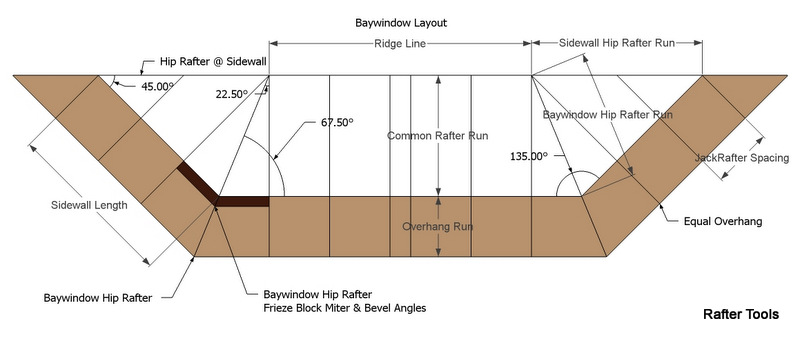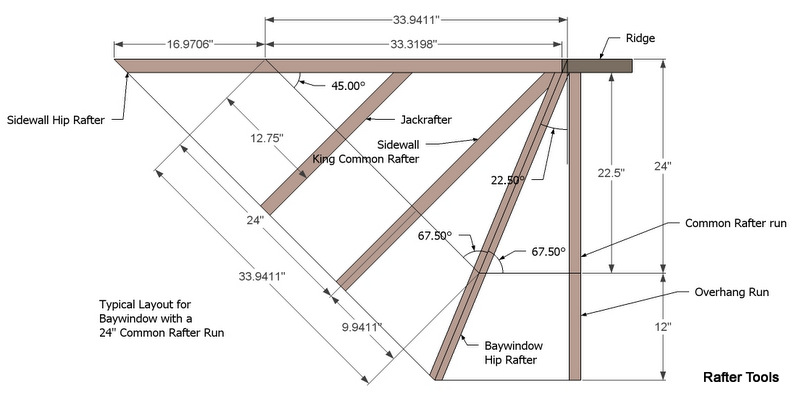The bay window script will calculate the angles and rafter lengths for a typical 45° baywindow
The corner angle of the bay window is 135° and the plan angle is 67.5°.
Bay window Roof Pitch or Angle
Select the input type from the input menu, Imperial/English Inch base 12 —— default, enter roof pitches from 1—24
like 8 for an 8:12 pitched roof, Metric 300mm base, enter millimeters like 200 for a 33.69007° roof pitch angle,
Decimal Inch base 10 —— enter base 10 decimal numbers like 5.7735 for a 30° roof pitch angle,
Degrees input —— use any roof angle in degrees like 33.69007°
- Length/Dimensions Input Menu Mode
- Imperial/English Inch base 12 —— default.. use American standard pitches over 12.
- Metric 300mm base —— 300mm is 11.81102 inches, similar usage to the American framing squares printed in inches.
- Decimal Inch base 10 —— use this option when working with tangents or using the Chappell Master Framing Square multiply the tangent of the angle by 10
The output mode selection can be completely different from the input mode
- Length/Dimensions Output Menu Mode
- Imperial/English Inch base 12 —— default.. use American standard pitches over 12.
- Metric 300mm base —— 300mm is 11.81102 inches, similar usage to the American framing squares.
- Decimal Inch base 10 —— use this option when working with tangents or using the Chappell Master Framing Square
Common Rafter Run
This menu option allows you to set the common rafter run of the baywindow roof for calculating the angles and dimensions of the
bay window roof. The Common Rafter Run will be from the outside of the exterior wall plate line to the building.
Overhang Run
This menu option allows you to set the rafter overhang run. The rafter overhang run will be equal on all 3 sides of the baywindow.
Seactcut Length
Enter a rafter seatcut length that will be used to determine the height of the heel cut (HAP) and the height to the top of the ridge.
Hip Rafter Width
Enter the Hip Rafter Width that will be used to determine the long point of the hip rafter length to ridge.
Ridge Width
Enter a ridge width that will determine the total the hip and common rafter lengths to the ridge.
Rafter Material Width
Enter the rafter material width that will be used to determine the placement of the sidewall jackrafter.
Rafter Material Depth
Enter the rafter material depth that will be used to determine the HAP of the rafters.
The Hip Rafter Length CL PP To Ridge is the center line layout dimension from plumb to plumb mark. Mark your bay window plumb mark on the hip rafter with this dimension.
The Hip Rafter Long Point Length To Ridge is the long point layout dimension from plumb to plumb mark on the side of the hip rafter. Mark your bay window plumb mark on the hip rafter then set your saw to 22.5° and bevel cut the baywindow hip rafter.
The Hip Rafter Drop for Roof Plane Alignment is the amount you drop the bay window hip rafter from the HAP, Height Above Plate, to align the top shoulder of the bay window hip rafter with the roof surface plane. The bay window hip rafters need to be lowered at the seatcut to allow the jackrafters, common rafters and the fascia to all align in the same roof plane. If you don't drop the bay window hip rafter seatcut then you will have to back out the bay window hip rafter shoulder s using the Hip Rafter Backing Depth Mark dimension that is perpendicular to the top edge of the hip rafter. Snap a line on the side of the hip rafter using the Hip Rafter Backing Depth Mark dimension and then set your saw to the Hip Rafter Backing Angle to bevel the edge of the hip rafter.
The Sidewall Hip Rafter Angle is used on the hip rafter next to the wall. The Sidewall Hip Rafter Angle is the standard hip rafter angle for an roof eave angle of 90° and a plan angle of 45°.
The Sidewall Hip Rafter Drop for Roof Plane Alignment is the amount you drop the sidewall hip rafter from the HAP, Height Above Plate, to align the top shoulder of the sidewall hip rafter with the roof surface plane. The sidewall hip rafters need to be lowered at the seatcut to allow the jackrafters, common rafters and the fascia to all align in the same roof plane. If you don't drop the sidewall hip rafter seatcut then you will have to back out the sidewall hip rafter shoulders using the Sidewall Hip Rafter Backing Depth Mark dimension that is perpendicular to the top edge of the hip rafter. Snap a line on the side of the hip rafter using the Sidewall Hip Rafter Backing Depth Mark dimension and then set your saw to the Sidewall Hip Rafter Backing Angle to bevel the edge of the hip rafter.
The Run To Ridge From Sidewall dimension is used set the end of the ridge. Use the Rise To Top of Ridge From Plate Line to set the height of the ridge.
Sidewall Jack Rafter Length dimension is to the long point of the jackrafter plumb cut. Set your saw to 45° to bevel cut the cheekcut of the jackrafter.
Sidewall King Common Rafter Length dimension is to the center point of the king common rafter plumb cut. Cut the plumb cut square then set your saw to 22.5° to bevel cut half of the cheekcut angle on the end of the king common rafter and leave your saw set at to 22.5° to finish off the 45° bevel cut that rest against the sidewall hip rafter.

